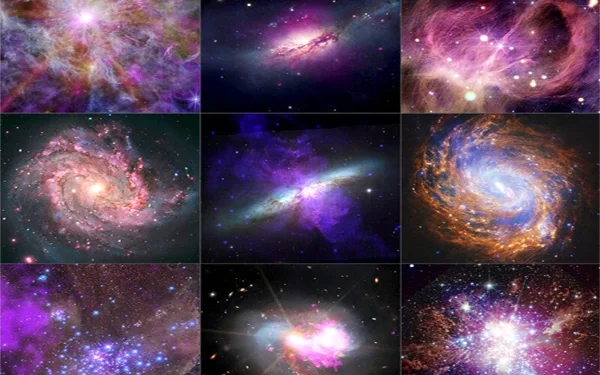In a remarkable feat of astronomical achievement, the National Aeronautics and Space Administration (NASA) has released a breathtaking series of galaxy images that offer an unprecedented glimpse into the distant universe. These vivid and scientifically rich images, captured through a combination of space-based observatories, are more than just visually spectacular—they represent decades of cutting-edge research and technological advancement in space exploration and astrophysics.
The newly released gallery comprises nine composite images showcasing star-forming regions, spiral galaxies, and galactic collisions. These images are the result of collaborative observations using NASA’s Chandra X-ray Observatory, the James Webb Space Telescope (JWST), the Hubble Space Telescope (HST), and several other cutting-edge instruments.
A Collaborative Space Science Triumph
The images were jointly released by NASA and the Harvard-Smithsonian Center for Astrophysics, highlighting the growing trend of multi-observatory collaboration. By combining data across multiple wavelengths—ranging from infrared to X-ray emissions—scientists can better understand the dynamic processes within galaxies, such as star formation, black hole activity, galactic collisions, and the structure of interstellar dust and gas.
Each observatory plays a unique role:
- Chandra X-ray Observatory captures high-energy X-rays, revealing explosive cosmic events.
- James Webb Space Telescope offers infrared imaging for penetrating dense dust clouds.
- Hubble Space Telescope provides high-resolution optical and ultraviolet data.
The integration of data from these observatories provides a multi-dimensional perspective of cosmic phenomena, allowing scientists and the public alike to see the universe in a new light.
Overview of the Featured Celestial Objects
Here’s a closer look at the nine fascinating celestial objects featured in the image release, each representing a different aspect of the universe’s grandeur:
1. N79: A Stellar Nursery in the Large Magellanic Cloud
Location: 160,000 light-years from Earth
Category: Star-forming region
N79 is part of the Large Magellanic Cloud (LMC), a satellite galaxy of the Milky Way. This region is a stellar nursery, where new stars are actively forming from vast clouds of gas and dust. Chandra’s X-ray vision reveals the energetic processes taking place within these young stars, while Webb and Hubble provide complementary views of the dust structures and nascent stars in infrared and visible light.
2. NGC 2146: The Warped Spiral Galaxy
Location: 44 million light-years away
Category: Barred spiral galaxy
NGC 2146 is a dramatic example of a distorted spiral galaxy, likely the result of gravitational interactions with a nearby galaxy. Its warped arms and turbulent dust lanes suggest ongoing starburst activity, where stars are forming at an accelerated pace. The combination of X-ray, infrared, and optical data highlights both the structure of the galaxy and the energetic feedback from supernovae and black holes.
3. IC 348: A Young Star Cluster in the Milky Way
Location: Within the Milky Way
Category: Star-forming region
Located in the Perseus Molecular Cloud, IC 348 is a relatively nearby region of active star formation. This young star cluster is home to hundreds of pre-main-sequence stars, many of which are still surrounded by protoplanetary disks—the early building blocks of planetary systems. X-ray data help detect energetic young stars, while JWST and Hubble provide detailed imagery of the surrounding dust and gas.
4. M83: The Southern Pinwheel Galaxy
Location: 15 million light-years away
Category: Grand-design spiral galaxy
Also known as the Southern Pinwheel Galaxy, M83 is one of the most photogenic spiral galaxies in the sky. It features well-defined spiral arms, a bright central bulge, and numerous star-forming regions. X-ray emissions highlight regions with recent supernova activity and black hole candidates, while optical and infrared data bring out the galaxy’s intricate structure and star clusters.
5. M82: The Cigar Galaxy – A Starburst Powerhouse
Location: In the Ursa Major constellation
Category: Irregular starburst galaxy
M82, commonly referred to as the Cigar Galaxy, is known for forming stars at a rate 100 times faster than typical galaxies. This intense activity makes it a prime example of a starburst galaxy. Chandra’s observations reveal the presence of hot gas blown out by supernovae, while Webb’s infrared capabilities penetrate the dense dust obscuring the galaxy’s core.
6. NGC 1068: The Squid Galaxy and Its Active Core
Location: Approximately 47 million light-years away
Category: Seyfert Galaxy (active galactic nucleus)
NGC 1068, nicknamed the Squid Galaxy, is a Seyfert galaxy with a highly active galactic nucleus (AGN). At its center lies a supermassive black hole that emits powerful X-rays as it consumes surrounding matter. This galaxy is a key object of study for scientists exploring the relationship between black holes and galaxy evolution.
7. NGC 346: Young Stars in the Small Magellanic Cloud
Location: Small Magellanic Cloud (SMC), ~210,000 light-years away
Category: Star-forming region
NGC 346 is one of the most dynamic star-forming regions in the SMC, featuring very young stars, some less than 2 million years old. These stars provide valuable insight into stellar evolution and the early stages of a star’s life cycle. This region is rich in hydrogen gas and dust, visible across the electromagnetic spectrum.
8. IC 1623: Colliding Galaxies in Action
Location: Around 300 million light-years away
Category: Interacting galaxy pair
IC 1623 is a spectacular collision of two galaxies, now merging into a single entity. Such galactic mergers are thought to be major triggers for starbursts, as gravitational interactions compress gas and dust, igniting intense star formation. The composite image reveals regions of shock waves, dust clouds, and newly formed stars.
9. Westerlund 1: A Super Star Cluster in Our Galaxy
Location: 12,000 light-years from Earth
Category: Young star cluster
Westerlund 1 is the youngest and most massive known star cluster in the Milky Way. It contains numerous rare and massive stars, including red supergiants, neutron stars, and possibly even black holes. Due to its relative proximity and dense star population, Westerlund 1 serves as an excellent laboratory for studying massive star evolution.
The Power of Multi-Wavelength Astronomy
What makes this image release particularly valuable is the application of multi-wavelength astronomy, a method that combines data across the electromagnetic spectrum to produce a more complete picture of cosmic phenomena.
- X-rays (Chandra) reveal high-energy events like supernovae, black holes, and stellar winds.
- Infrared (JWST) penetrates dense clouds of gas and dust, revealing young stars and planetary systems.
- Optical and Ultraviolet (Hubble) highlight starlight and galactic structures.
This approach not only produces visually striking images but also deepens scientific understanding of how galaxies form and evolve, how stars are born and die, and how black holes influence their environments.
Why These Images Matter
These images are more than scientific eye candy—they serve multiple important purposes:
- Public Engagement: High-resolution cosmic images ignite public interest in astronomy and space science.
- Educational Resources: They serve as powerful tools for teaching topics like star formation, galactic dynamics, and black hole physics.
- Scientific Discovery: Each image is part of a broader research initiative that advances knowledge of the universe’s fundamental processes.
Looking to the Future
As NASA continues to expand its fleet of space telescopes, including the upcoming Nancy Grace Roman Space Telescope, and as international collaboration grows through agencies like ESA and JAXA, the ability to explore the universe in greater depth will only increase.
With Chandra, Webb, and Hubble still active and delivering groundbreaking data, the next generation of images and discoveries will likely surpass even today’s marvels. These visualizations remind humanity of the vastness, beauty, and mystery of the cosmos—and the endless possibilities that lie ahead in our pursuit of knowledge.
Conclusion
The release of these nine awe-inspiring images by NASA and its partners provides not only a feast for the eyes but also a wealth of scientific information. By combining the strengths of the Chandra X-ray Observatory, James Webb Space Telescope, and Hubble Space Telescope, researchers continue to unravel the complex tapestry of our universe.
As technology advances and observation techniques improve, our window into the cosmos grows clearer, offering profound insights into galactic evolution, star formation, and cosmic history.

























